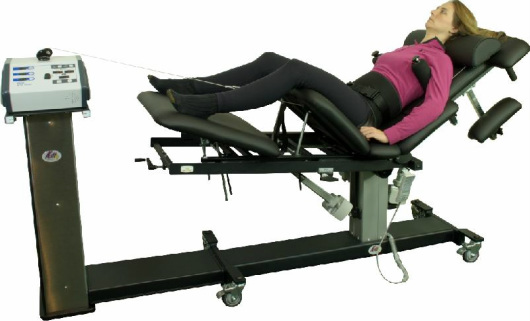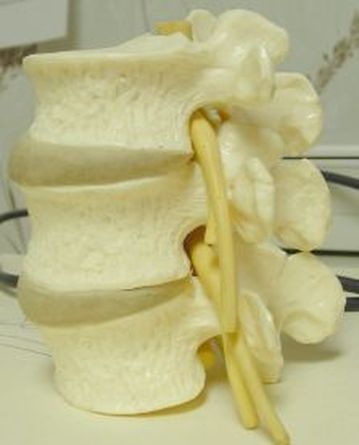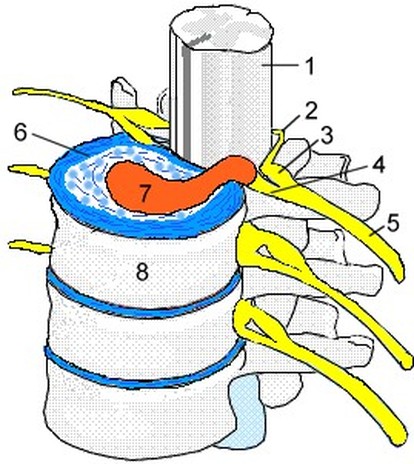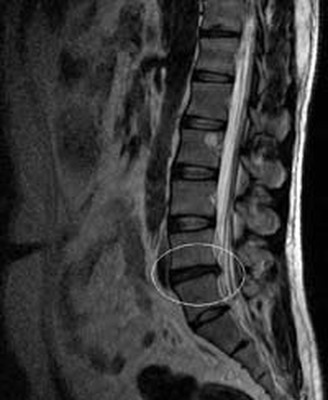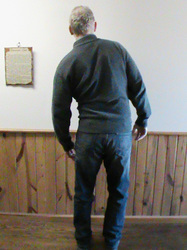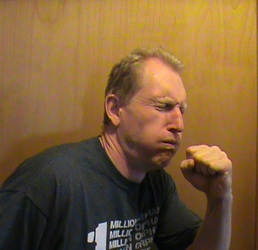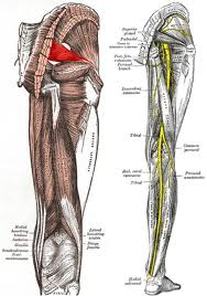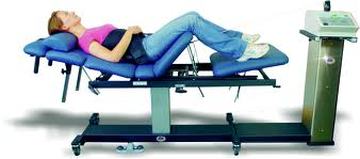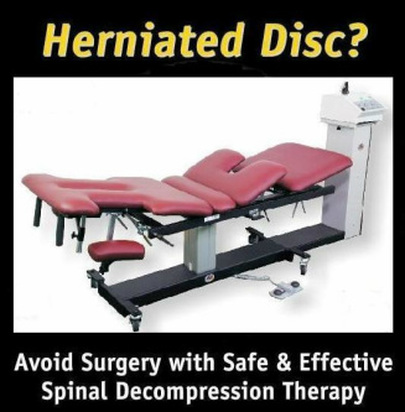HOW DOES DECOMPRESSION THERAPY WORK?
In order to understand how Spinal Decompression Therapy works, we must take just a moment to review a little bit of Spinal Anatomy. In the spine, there are 24 vertebrates. In between most of these vertebrates are cushions called Intervertebral Discs. Spinal Discs have several functions, but two stand out above the others.
- They create space inside the Intervertebral Foramen (see picture below):
- They act as a shock absorber ("cushion" or "bushing") between the vertebrates:
The vertebrae are held in place with LIGAMENTS, MUSCLES / FASCIA, and TENDONS. As you will see in the pictures below, the Spinal Disc gives height to the Neural Foramen (sometimes called the Intervertebral Foramen or IVF ---- sometimes called the 'Neural Foramen'). This is important to understand because the Spinal Nerves come off of the Spinal Cord, exit the spinal canal through the Neural Foramen (it's kind of like a "window" between any two adjacent vertebrates), and continue on to the various glands, muscles, organs, and tissues that they regulate and control (HERE). If you look at the middle picture in the second row below, you will notice that the the disc is made up of two distinct parts. These are.......
- The Outer Annulus: The outer layer (or more appropriately, "layers") of the disc is called the Annulus Fibrosus and is made up of lots and lots of ligaments. If you were to look at a Spinal Disc under a microscope, you would notice that the Annular Ligaments wrap around and around and around the center of the disc. This is because The Annulus job is to hold The Nucleus (the jelly center) in place. How does it do this? Think of a baseball here. If you have ever cut open a baseball (or even an old golf ball), you will find lots and lots of rubber bands coiled around a center core. Only instead of a core made of rubber or cork, the disc's core is made up of jelly.
- The Inner Nucleus: The Nucleus, Technically called the Nucleus Pulposus, is the jelly-like center of the disc. Because it is a thick jelly-like fluid, it has the ability to push outwards in all directions. Bend to one side, and the disc tends to push toward the other. Bend forward, and the nuclear jelly pushes toward the back of the disc.
NORMAL INTERVERTEBRAL DISCS
OR
INJURED SPINAL DISCS
- SPINAL CORD: The spinal cord sends messages from the brain to the body, and the body to the brain.
Be aware that 2, 3, 4, & 5 are all part of the SPINAL NERVE. - DORSAL NERVE ROOT: This is the sensory part of the nerve.
- DORSAL ROOT GANGLION: This is a large bundle of cell bodies.
- VENTRAL NERVE ROOT: This is the motor portion of the nerve. It is the part of the nerve that makes things happen in your body.
- SPINAL NERVE: When the two nerve roots (Dorsal & Ventral) become one, we call this a spinal nerve.
- ANNULUS FIBROSUS OF THE DISC: The Annulus is made up of concentric rings of ligaments (like tree rings). These ligaments hold the Nucleus Pulposus in place.
- NUCLEUS PULPOSUS OF THE DISC: The Nucleus Pulposus is the "Jelly" center of the disc. Because it is a jelly, it has the ability to flatten out when bearing loads. If the load is too great, the Annular fibers begin to tear, which allows the Nucleus Pulposus to start pushing its way out of the disc and creating a "bulge". The picture above represents a Herniated Disc. This person would have symptoms in their left lower back and legs.
- VERTEBRAL BODY: This is the vertebrate itself.
- NOT WELL DEPICTED IS THE INTERVERTEBRAL FORAMEN (or I.V.F.): The IVF is simply the "window" or opening between any two adjacent vertebrate. It allows the individual Spinal Nerve exit the spinal cord and travel to the various organs, muscles, tissues, and glands that they control. The IVF is easier to see in the picture on the left.
Anything that encroaches on the Intervertebral Foramen (IVF) will compete with the nerve for space. As you can imagine, it is not a good thing for the nerve to be pressed or encroached upon. It's pretty easy to understand that the nerve needs a certain amount of room as it comes through the bony window we call the IVF. When the nerve does not have the room it needs to stretch and move, it can become "pinched" or severely irritated. As you can also imagine, this is not a good thing either. How does this happen? Follow along as I walk you through the process.
As the Spinal Discs bear loads, the pressure pushes the nucleus outward in all directions. If there is a weak spot in the disc's outer Annulus, the most inner layers (near the Nucleus) begin to tear. As they tear, the jelly center (The Nucleus) begins to push its way toward the outside. Bear in mind that disc herniations rarely happen in the front part of the disc. Because people tend to lean forward (not backward) and bend side to side, the pressure tends to push the nucleus toward the back of the disc. This is where discs tend to rupture --- to the back and just lateral of the midline.
Full-blown Disc Herniations rarely happen all at once. Much more common is a Progressive Disc Injury. As the disc is continually stressed, the annulus continues to tear just a little bit more; allowing the nucleus "slip" a little bit more ---- always creating a little bit bigger bulge and putting a little bit more pressure on the nerve. But then it heals some, and might even feel better for awhile. In other words, it's not an "all-or-none" proposition. It is usually a process where a disc goes from normal to ruptured over time ---- even though the terrible pain might have come on all at once.
And while you will hear terms bantered around such as "Slipped Disc," "Herniated Disc," Ruptured Disc," etc, the question to ask is whether the disc is Contained or Non-Contained. As long as the Nucleus is contained within the Annulus, there is a fighting chance that you can avoid surgery. But if the Nucleus slips completely outside of the Annulus ---- a "Non-Contained" lesion...... Unfortunately, you might have a surgical problem on your hands. Unless your neurosurgeon says otherwise (AND MAYBE EVEN AGAINST THEIR WISHES), you should consider Spinal Decompression Therapy! Unless you have a severe or rare problem such as a CAUDA EQUINA SYNDROME, Spinal Decompression Therapy might be worth a try.
Lateral View of the Lumbar Spine (the person is facing to your left). Notice the circled disc between the L4 & L5 vertebrate. This is the Ruptured Disc. The Nuclear material is trying to push all the way through the Annulus. The disc is pushing not only onto spinal nerves, but you can see it pressing into the spinal cord as well. Notice how black the disc is? In the other discs, you can actually see the Nucleus Pulposus (the white center). The circled disc is completely black. Would this person respond to Spinal Decompression Therapy? Probably. Avoid spinal surgery because it is such a crapshoot!
CARDINAL SIGNS OF A HERNIATED DISC
There are three Cardinal Signs that I look for in determining if someone might have an Injured Disc. They are.....
- ANTALGIA: An antalgic posture is leaning to one side or the other (or to the front). If the Nucleus Pulposus "slips" or herniates to the right, most of the time people will lean to the left and vise versa. This is an automatic reaction of the body as it tries to pull you off of, or away from the bulging nucleus. Often times you will notice that the belly button is pulled away from the body's center line.
- POSITIVE VALSALVA or DeJARINE SIGN: This is pain when you cough, sneeze, or strain on the stool. When you cough or sneeze, you develop a great deal of momentary internal pressure. Because force always takes the path of least resistance, the pressure released by a cough or sneeze pushes on the bulged portion of the disc. I frequently hear people tell me that if they know they are going to cough or sneeze, they hold themselves up in a counter or table so their legs do not collapse out from under them in sheer pain. Speaking of legs......
- SCIATICA: The nerves from either side of your low back area grow together into one nerve ---- the Sciatic Nerve. The Sciatic Nerve is not only the longest nerve in the body, it is the biggest as well. If you cause pressure on one of the nerves that makes up the Sciatic Nerve, you can end up in a world of hurt. This can be in the form of pain. But it can also be in the form of numbness, tingling, weakness, odd sensations (paresthesia), etc. Sometimes the pain will do odd things like start at the knee and go down, or skip certain areas. Sciatica can also mimic knee or hip problems as well.
ANTALGIA POSITIVE VALSAVA MANEUVER / DeJARINE'S TEST SCIATICA
(Leaning away from the pain) (Pain when coughing, sneezing, straining) (Pain, numbness, tingling in leg)
(Leaning away from the pain) (Pain when coughing, sneezing, straining) (Pain, numbness, tingling in leg)
PIRIFORMIS SYNDROME / BUTT-BASED SCIATICA
One quick word about Piriformis Syndrome. Piriformis Syndrome is literally a "pain in the butt" that can sometimes mimic a disc problem, even though it is ultimately caused by a problem with a muscle. If you have little or no low back pain but lots and lots of buttock pain (or chronic Sacroilliac pain), this might very well be your problem ---- especially if you are female (notice the relationship of the Piriformis Muscle and the Sciatic Nerve in the picture below). To understand the difference between a Herniated Disc and Piriformis Syndrome, please take three minutes and visit the most comprehensive Piriformis Syndrome site on the web (HERE).
RIGHT LEG
Notice the proximity of the Sciatic Nerve (Yellow) to the Piriformis Muscle (Red)
DEGENERATIVE INTERVERTEBRAL DISCS
This topic brings me to one of my biggest pet peeves ---- DJD (sometimes called DDD). DJD is a relatively new term and stands for Degenerative Joint Disease (DDD = Degenertaive Disc Disease). Using the word "Disease" next to the words "Degenerative Disc" is largely a misnomer (not to mention, a brilliant marketing ploy). Just convince people they have a "disease" in their spine, scare the dickens out of them, and they will be ready to do whatever is suggested. Surgery anyone?
Although a diet of heavily processed foods, smoking, a sedentary lifestyle, etc, can cause the degeneration of the Collagen-Based Connective Tissues (bones, ligaments, and discs); doctors never seem to mention this fact. However, there is another common cause of Spinal Degeneration besides those mentioned above. Degeneration of any joint is caused by loss of, or abnormal motion of that joint. If a joint is not moving properly, it is wearing out! But if it is wearing out, it is not moving properly. It is a self-perpetuating cycle that your doctor will likely blame on your age ---- regardless of how old you are.
Spinal Discs are an avascular tissue. This means that they have no blood supply. The only way that they can receive all the things normally carried by the blood --- water, nutrients, and oxygen --- is via joint motion. Joint Motion t's also the way they must get waste products out of the disc. When we see global (whole spine) degenerative changes such as thin discs, bone spurs, and calcium deposits from the neck to the low back; we know that this person probably has age-related degenerative changes. However, when we see local (confined to a very specific area) degenerative changes (the earlier pictured MRI), we know that injury and subsequent abnormal motion is almost certainly the culprit.
Remember the progression of the Herniated Disc in the section above? Degenerative Discs act much the same way. Small injuries cause fibrotic tissue (scar tissue) to form deep in the spinal joint (think Annulus here). As you can imagine, scar tissue is not nearly as flexible or elastic as normal tissue (for pictures GO HERE). As the back is repeatedly injured (sports, work, weight lifting, motorcycle racing, bull riding, too much sitting, etc), scar tissue builds up until it surrounds the two vertebrates and the disc between them. As you might have already guessed, the result of this fibrotic tissue is loss of joint motion. Loss of joint motion over time is the known cause of deterioration --- including affected Intervertebral Discs.
Loss of joint motion causes degenerative changes, and degenerative changes cause loss of joint motion. Repeat until the joint is worn completely out! It is the vicious cycle that I speak about at length on THIS POST.
Although a diet of heavily processed foods, smoking, a sedentary lifestyle, etc, can cause the degeneration of the Collagen-Based Connective Tissues (bones, ligaments, and discs); doctors never seem to mention this fact. However, there is another common cause of Spinal Degeneration besides those mentioned above. Degeneration of any joint is caused by loss of, or abnormal motion of that joint. If a joint is not moving properly, it is wearing out! But if it is wearing out, it is not moving properly. It is a self-perpetuating cycle that your doctor will likely blame on your age ---- regardless of how old you are.
Spinal Discs are an avascular tissue. This means that they have no blood supply. The only way that they can receive all the things normally carried by the blood --- water, nutrients, and oxygen --- is via joint motion. Joint Motion t's also the way they must get waste products out of the disc. When we see global (whole spine) degenerative changes such as thin discs, bone spurs, and calcium deposits from the neck to the low back; we know that this person probably has age-related degenerative changes. However, when we see local (confined to a very specific area) degenerative changes (the earlier pictured MRI), we know that injury and subsequent abnormal motion is almost certainly the culprit.
Remember the progression of the Herniated Disc in the section above? Degenerative Discs act much the same way. Small injuries cause fibrotic tissue (scar tissue) to form deep in the spinal joint (think Annulus here). As you can imagine, scar tissue is not nearly as flexible or elastic as normal tissue (for pictures GO HERE). As the back is repeatedly injured (sports, work, weight lifting, motorcycle racing, bull riding, too much sitting, etc), scar tissue builds up until it surrounds the two vertebrates and the disc between them. As you might have already guessed, the result of this fibrotic tissue is loss of joint motion. Loss of joint motion over time is the known cause of deterioration --- including affected Intervertebral Discs.
Loss of joint motion causes degenerative changes, and degenerative changes cause loss of joint motion. Repeat until the joint is worn completely out! It is the vicious cycle that I speak about at length on THIS POST.
WHAT DOES SPINAL
DEGENERATION LOOK LIKE?
Spinal Degeneration is characterized by three main findings on X-ray or MRI.
- BONE SPURS: Bone Spurs are just that; tiny spurs of bone that can eventually grow together (sometimes they look a lot like bird's beaks). Bone Spurs are always seen with both SPINAL STENOSIS and DEGENERATIVE DISCS Most of the time, spinal pain is not caused by the spur; but the spur is the result of abnormal motion over time. You will typically see bone spurs referred to as osteophytes on a radiology report. If the bone spurs from the vertebrate above, grow until they actually "meet" bone spurs from the vertebrate below, they are referred to as syndesmophytes. This is not good because it means that a non-surgical spinal fusion is starting to to take place. One of the dirty little secrets of the medical profession is that rarely are spinal bone spurs or calcium deposits the villain that is actually causing your back or leg pain. They are simply a sign of abnormal joint motion over many years ---- a sign that stands out like a sore thumb on x-ray.
- CALCIUM DEPOSITS: Again, just like it sounds, calcium deposits are deposits of bone that are laid down by the body in places that they should not be. This something that is always seen in SPINAL STENOSIS and DEGENERATIVE DISCS. It is the body's way of trying to stabilize itself. You will sometimes hear of products that claim to "remove" bone spurs or calcium deposits. Because both calcium deposits and spurs are made up of bone that is bio-identical to the bone around them, nothing is going to remove bone spurs short of surgery. But remember, the spurs and calcium deposits are rarely the things causing your pain. A much bigger problem than calcium deposits is........
- THINNING DISCS: Discs thin because of abnormal (usually loss of) motion over time. Think about it for a moment. The goal of chiropractic adjustments is to restore both alignment and motion to the spinal vertebrates. Decompression Therapy helps with both of those things. Why is it so important to take care of your spine? If you wear out a knee or a hip, you simply have it replaced. Not optimal, but good enough to get by. Wear out your spine and you are stuck with it. Doctors used to do spinal surgeries for disc degeneration. However, they rarely do surgery for DEGENERATIVE DISCS any more. Why not? They know it does not work (VISIT OUR BLOG). But what does work?
SPINAL
DECOMPRESSION
THERAPY WORKS!
But How Does it Work?
Non-Surgical Spinal Decompression Therapy uses computerized traction patterns to gently stretch the spine and decompress the Intervertebral Discs. Spinal Decompression Therapy creates a negative pressure ("vacuum effect") inside of the Spinal Disc. This negative pressure helps to "suck" the Nuclear Jelly back inside the Annulus of the targeted vertebrate(s). A great way to think of this is to think about flying in a jet.
As jets climb higher and higher, there is less and less atmospheric pressure. What does the airline have to do in order to insure that people can survive at altitudes in excess of six miles? They pressurize the cabin. Most of us have seen some sort of movie involving terrorists and jet airplanes. Something happens during flight (a window is knocked out, or a door is somehow opened). Immediately, people, seats, luggage, and whatever else is in the vicinity is sucked right out of the plane ---- like a giant vacuum! Now think about why this happens. Things move from areas of greater pressure to areas of less pressure. This is why it is easy to air up a car tire at first. But once the it starts getting full, the pressure inside of the tire begins to equalize with the pressure outside of the tire.
When we can create negative pressure inside of the disc via Spinal Decompression, it helps to "suck" extruded nuclear jelly and fluid back inside of the annulus. In Spinal Decompression Therapy, this is known as the "Vacuum Effect", and is exactly what we are looking for. A negative pressure inside of the disc literally "sucks" or "pulls" the Nucleus Pulposus back inside of the torn Annulus Fibrous.
Once the Nucleus has been drawn inside the Annulus, the pressure begins to come off of the spinal nerves and spinal cord, and the Annular Ligaments that hold the Nucleus in place can begin to heal. Bear in mind that each individual treatment only pulls the disc apart a little bit. But over the course of a six week Spinal Decompression Therapy Protocol, the results can be amazing.
WHO BENEFITS FROM SPINAL DECOMPRESSION THERAPY?
There are several groups of Chronic or Acute Low Back Pain Sufferers who are likely candidates to be helped by Decompression Therapy. This group includes those diagnosed with
- HERNIATED DISCS
- DEGENERATIVE DISCS
- SCIATICA (leg pain or numbness / tingling)
- FAILED BACK SURGERY SYNDROME
- SPINAL STENOSIS
- FACET SYNDROME
People with certain conditions are not candidates for spinal decompression therapy. Some of the more common of these include:
- Tumors
- Abdominal Aortic Aneurism
- Fractures
- Pregnancy
- Certain conditions (diseases) that compromise the structural integrity of the spine and discs. These conditions are present in only a small percentage of the population.
For more information, or to schedule a free consultation with Dr. Schierling, please call (417) 934-6337 or CONTACT US HERE.
|
Disclaimer: The material provided on this site is for strictly informational purposes only. It is not meant to replace or substitute for the recommendations or advice of your physician or medical provider. The products are not intended to diagnose, treat, cure or prevent disease. The information contained in this site should not be used for diagnosing or treating a health problem or disease. If you believe you have a medical condition or problem contact your health care provider. The statements contained in this website have not been evaluated by the Food and Drug Administration. |
THE WEBSITES OF SCHIERLING CHIROPRACTIC, LLC
|
www.DoctorSchierling.com
www.DestroyChronicPain.com www.DestroyTendinitis.com www.DestroyPiriformisSyndrome.com www.BBTMO.com www.DestroyObesityToday.com www.ColdLaserCure.com www.SpinalDecompressionMissouri.com www.DestroyFibromyalgia.com www.EndoGut.com www.ThyroidEpidemic.com www.DestroyMigraineHeadaches.com |
GENERAL INFORMATION
SCAR TISSUE REMODELING: CHRONIC PAIN WE FIX TENDINITIS / TENDINOSIS PIRIFORMIS SYNDROME / PAIN IN THE BUTT BRAIN-BASED THERAPY WEIGHT LOSS & OVER ALL HEALTH COLD LASER THERAPY IS HOT! NON-SURGICAL TREATMENT OF DISCS THERE IS HOPE FOR YOU IMMUNE & ENDOCRINE SYSTEM / GUT THYROID EQUALS METABOLISM HEADACHES STEAL YOUR LIFE |
